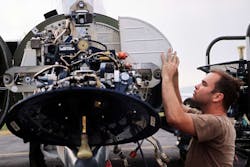Military avionics experts ask Northrop Grumman to provide legacy radar antennas for B-1 bomber aircraft
OGDEN, Utah – U.S. military logistics experts needed low-observable antennas for legacy offensive radar systems aboard the U.S. Air Force B-1B Lancer strategic jet bomber. They found their solution from Northrop Grumman Corp.
Officials of the U.S. Defense Logistics Agency aviation office in Ogden, Utah, announced a $121.5 million contract on 20 Dec. to the Northrop Grumman Mission Systems segment in McLean, Va., for AN/APQ-164 offensive radar low observable antennas for the B-1 aircraft.
The B-1 was designed in the early 1970s, but the program was cancelled by then-President Jimmy Carter in 1977 shortly after Carter took office. Carter's successor, President Ronald Reagan, reinstated the program in the early 1980s, and the B-1 entered Air Force service in 1986.
The B-1 bomber is designed as a supersonic low-level penetrating bomber able to carry nuclear and conventional bombs and missiles. The aircraft uses speed at low altitudes and a sophisticated electronic warfare (EW) system to defeat enemy air defenses.
Related: B-1 bomber radar systems set for big technology upgrades with Northrop-Grumman SABR-GS
Air Force officials announced in 2019 that they will retire the B-1 in favor of the future B-21 Raider stealth bomber. The B-1B will remain in service for some time, but unlike its older cousin the B-52, its days are apparently numbered. The B-1B has served in a variety of capacities since the 1980s, demonstrating a degree of mission flexibility.
Late-model B-1 aircraft have received upgrades to install the Northrop Grumman Scalable Agile Beam Radar-Global Strike (SABR-GS) -- a multi-function active electronically scanned array (AESA) radar developed as an affordable low risk radar retrofit for the B-1. SABR-GS is replacing the APQ-164 radar antenna deployed on late-model B-1 bombers.
Large synthetic aperture radar like the SABR-GS provides the B-1 with advanced image processing, and sensor integration for situational awareness and intelligence, surveillance, reconnaissance, and targeting.
The SABR-GS radar system design is based on open-architecture standards to integrate data from other onboard sensors to facilitate life cycle maintainability and continued system upgrades.
Related: Air Force considering AESA radar upgrades for B-1 and B-52 strategic bomber fleets
SABR-GS is a derivative of the AN/APG-83 SABR that takes advantage of hardware, legacy modes, and advanced operating modes on the F-35, F-22, and F-16 jet fighter aircraft. Nearly three times the size of the F-16 SABR system, SABR-GS offers target area detail and digital maps under all weather conditions, company officials say.
Northrop Grumman developed the SABR-GS under a $21 million risk-reduction contract awarded in 2011 by the Air Force B-1 Systems Program Office. Northrop Grumman has flight-tested the advanced B-1 AESA and advanced sensor and fusion processing, readying the radar for engineering, manufacturing and development (EMD).
On this contract Northrop Grumman will do the work in Oklahoma City, and should be finished in December 2028. For more information contact Northrop Grumman Mission Systems online at www.northropgrumman.com/who-we-are/business-sectors/mission-systems, or the Defense Logistics Agency-Aviation at www.dla.mil/Aviation.
